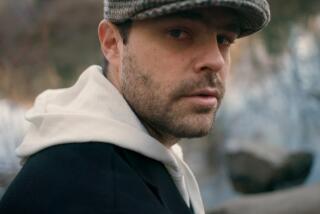Symbol of Argentine ‘Dirty War’ Is Again Freed
- Share via
BUENOS AIRES — For nearly a decade, Alfredo Astiz, a young naval officer, and Dagmar Hagelin, an Argentine-Swedish teen-ager who was 17 when she disappeared, have been international symbols of Argentina’s “dirty war” against terrorism and the search for justice in its aftermath.
They met again Monday--by proxy--in the chambers of the Supreme Council, Argentina’s highest military tribunal. And for the fourth time in five years, an Argentine court ruled that there was insufficient evidence to prove a charge that Astiz shot the girl in 1977, bundled her into the trunk of a car and took her to a clandestine detention and torture center.
Hagelin, who had chanced upon a raid by military intelligence agents arresting a friend of hers, is one of an estimated 9,000 people still missing from a struggle between the armed forces and Marxist guerrillas that was waged here beginning in the mid-1970s. Many of those missing, known as the desaparecidos (the disappeared ones), were civilian sympathizers of the guerrillas.
Case Reopened
Two navy tribunals had previously cleared Astiz, a lieutenant, and so had the Supreme Council, which reopened the case at the insistence of a civilian appeals court.
Noting that the council overrode the testimony of witnesses in reaching its verdict, lawyer Luis Zamora, who represents Hagelin’s father with support of the Swedish government, said he will appeal to a civilian court. The father, Ragnar Hagelin, expressed outrage.
Monday’s action by the Supreme Council follows an order to military courts last week by President Raul Alfonsin to speed up trials of officers accused of human rights abuses.
The council apparently had already reached its decision in the Hagelin case before the presidential order was received, but spokesmen for human rights groups say they fear that it is the harbinger of future rulings by military courts.
In his order, Alfonsin also instructed the military courts to distinguish between senior officers directly responsible for the abuses and those who carried out orders in obedience to their superiors. The effect will be to free junior officers from threat of prosecution except in cases where they themselves committed flagrant abuses.
National Trauma
The action was widely seen as an attempt by Alfonsin to resolve Argentina’s lingering trauma over the era of the “dirty war” and at the same time to ease tensions within the military officer corps.
Gen. Hector Rios Erenu, the army commander, said Alfonsin’s action “brings tranquility to the junior officers. . . . This clarification is a more adequate framework in which to await final judgments by the courts.”
Human rights groups protested, however. One charged that the action will give “impunity to those who executed crimes of state terrorism.”
The armed forces, which ruled from 1976 until Alfonsin took office at the end of 1983, have strongly opposed the human rights trials, charging that accused officers are being persecuted for winning a war they never sought.
Symbol for Officers
As the most prominent junior officer to be directly accused, Astiz has become a symbol not only abroad in such countries as Sweden, but also to the entire Argentine officer corps.
In all, about 300 accusations against active and former officers are pending in Argentine courts. Five former military junta leaders, including two former presidents, are serving prison sentences handed down by a civilian court that tried them on Alfonsin’s instructions. There have been no other convictions.
A retired admiral’s son in his mid-30s, Astiz still faces charges in the 1977 disappearance of two French nuns. He has been cleared by a court-martial for his role in surrendering an Argentine garrison he commanded to British forces during the 1982 war for the Falkland Islands.
More to Read
Sign up for Essential California
The most important California stories and recommendations in your inbox every morning.
You may occasionally receive promotional content from the Los Angeles Times.













